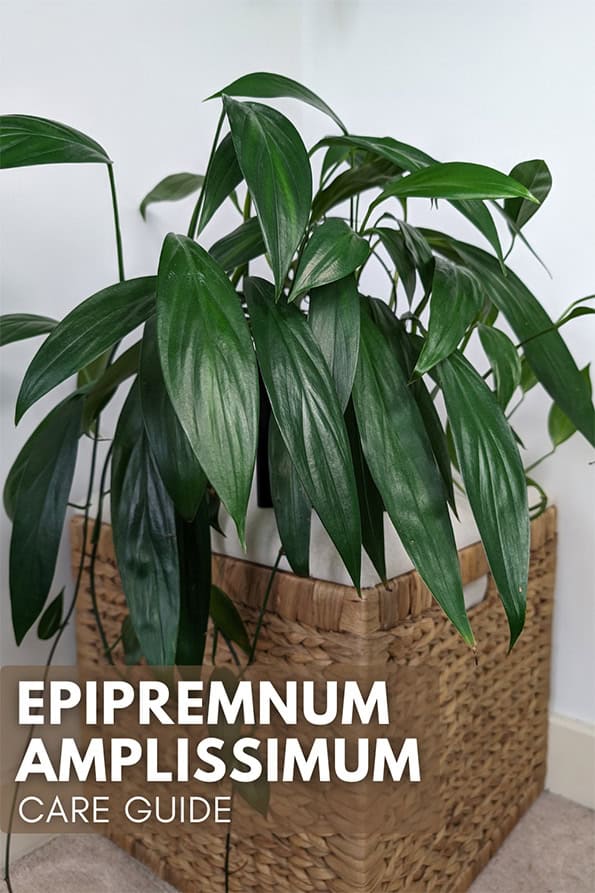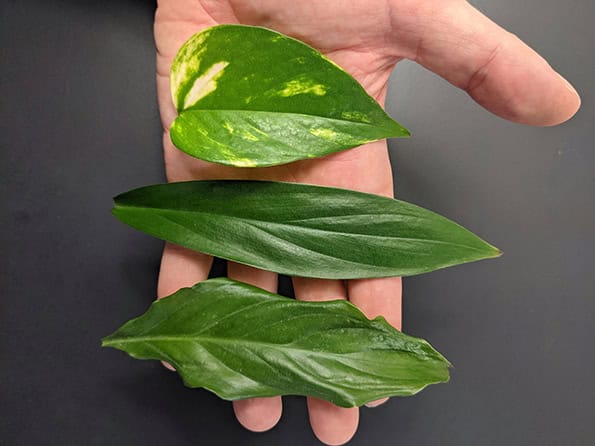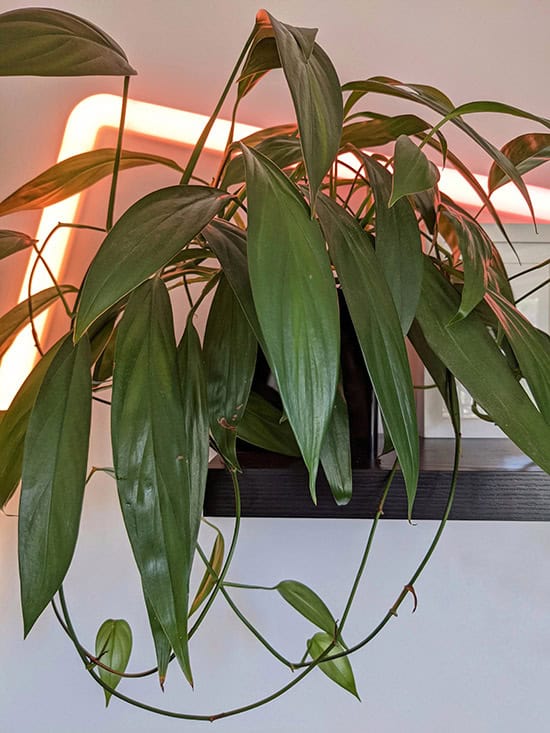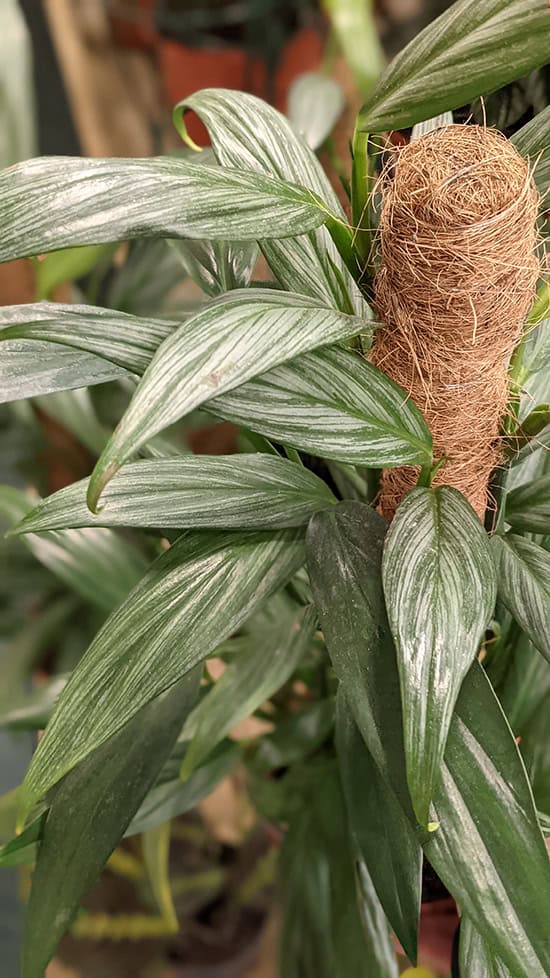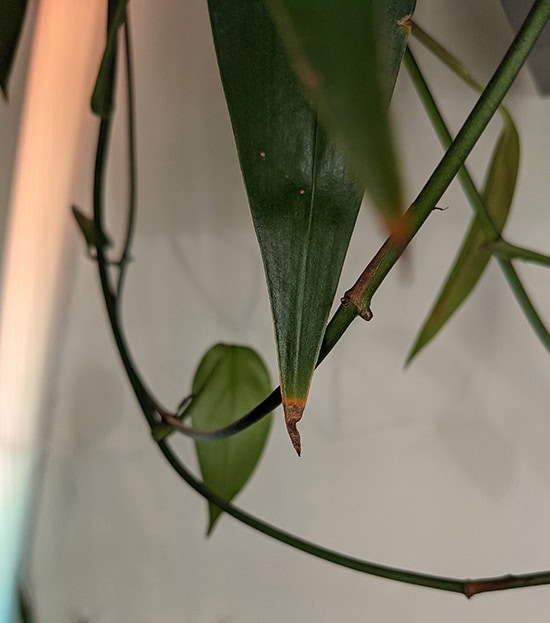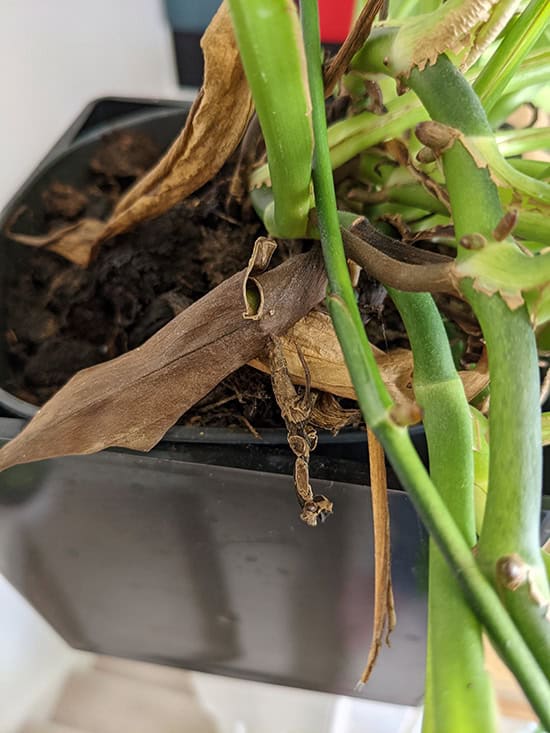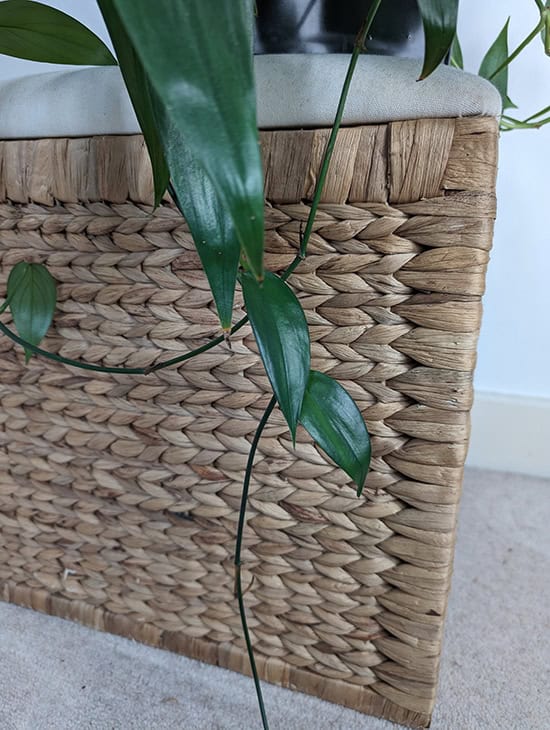Epipremnum amplissimum is a species of tropical vine known for its glossy, lance-shaped leaves which can grow up to several feet long. It has an easy going nature and adapts well to being grown as a houseplant.
Belonging to the Araceae family and directly related to the more common Pothos, it's native to Southeast Asia and will thrive in a warm home. This is an attractive pick if you want a Pothos like beginner plant, but are looking for something a little different visually.
Sometimes known as Pothos Amplifolia, the Epipremnum Amplissimum Pothos has dark green, long leaves. They can be grown as hanging plants, or allowed to trail like this.
The plant thrives in warm, humid environments with good light levels. However, it will adapt to various light conditions, copes with average temperatures, and deals with most humidity levels in the average home.
How do you pronounce Epipremnum amplissimum correctly? Say:
eh-pih-PREM-num am-PLIS-ih-mum
Epipremnum amplissimum is a species in the genus Epipremnum and is, therefore, closely related to the more familiar Pothos plant. As a result it has almost identical care needs when grown as a houseplant. This is excellent news because anyone who has owned a Pothos will know they're super simple plants.
Is It Rare?
I'd say it's more uncommon than rare. It's true that Epipremnum amplissimum is pretty hard to chance upon in most shops. However plenty of shops sell them online for reasonable prices.
They do differ in looks though. In fact I'd say the Epipremnum amplissimum looks more like a Peace Lily (Spathiphyllum) than a normal Pothos.
Although if you look close enough you can see similarities.
My photo below shows me holding leaves from all three plants. From top to bottom, a Golden Pothos, Epipremnum amplissimum and one belonging to a Peace Lily. Let me know if you agree.
Top to bottom, a Golden Pothos, Epipremnum Amplissimum, and Peace Lily leaf.
In terms of varieties, there are three main ones around at the moment. The most common is the all green variety, which I own and features in the photos of this post.
There are two popular variegated versions, Epipremnum Amplissimum 'Silver Streak' is the most popular. The Silver Streak Pothos, as its name suggests, has silvery, metallic, streaks over its leaves.
You may also come across one with patches of solid yellow variegation known as Epipremnum Amplissimum Aurea Variegata / Variegated.
Both are very pretty and worth searching out if the regular green form doesn't do it for you, or if you want to add them to an existing collection. If I come across either for a good price I'd like to give them a go. If you have them, tell me your opinion of them.
Up next are the care needs for the plant.

Hi, I'm Tom!
If you're like me and enjoy the challenge of growing houseplants and getting them to thrive, then Ourhouseplants can help. This website shares my knowledge and years of growing plants and provides (hopefully) helpful advice on properly caring for your indoor plant friends.
It's an adaptable plant. Coping with some bright spots with a little sun in the mornings or late afternoon, but it will also do OK in shady, lower light locations if needed.
It typically prefers bright, indirect light for optimal growth. As mentioned, it can easily tolerate lower light conditions, but its growth may slow down and the gaps between the leaves may increase. This can make the plant look less "full" as time goes on. Additionally, long leafless stems may be produced.
Did You Know?
"Epi" means "upon" or "above," and "premnon" refers to "trunk" or "stem." Therefore, "Epipremnum" roughly translates to "upon the stem" or "growing on a stem."
The word "amplissimum" means "large" or "most abundant." So together, the full Latin name reflects the plant's natural upward growth and its notable large leaves.
I've found the Epipremnum amplissimum to have moderate watering needs. Mine grows in a low light area and typically dries out within a week or so. At this point, the leaves hang down and droop a little, informing me that it wants a drink.
The general approach should be to water thoroughly allowing water to flow out of the drainage holes at the bottom of the pot. This ensures that the entire root ball is well watered.
Like other Pothos plants, Epipremnum amplissimum is susceptible to yellowing leaves or root rot if heavily overwatered. Allow the soil to dry out slightly between waterings to prevent waterlogged conditions.
Slight overwatering can cause dripping leaves. If this happens over a prolonged period salts can collect at the leaf tips that sometimes trigger brown ends.
Plants will use less water over winter, in low light, or if they've been placed in a cooler room, so adjust accordingly. Again, if you wait until the potting mix has almost dried out fully, you should be fine.
The plant is adapted to moderate to high humidity environments, replicating its natural tropical habitat. So aim for humidity levels above 50% to promote healthy growth and prevent leaf browning or curling.
They can normally deal with lower humidity, but watch for any issues with the leaves like browning tips and edges. Leaves may also be shorter or stunted. If you see this, then additional humidity support may be needed.
During the active growth period, usually in Spring and Summer, your Epipremnum amplissimum will benefit from regular feeding. Dilute a balanced liquid fertilizer to half strength and apply every 4-6 weeks.
Plants not growing or over the Winter months won't need as much feed. So be careful to avoid over-fertilization, as it may result in salt accumulation and harm the plant's root system.
Relatively low-maintenance and forgiving, makes it suitable for beginner plant enthusiasts. It tolerates a wide range of light conditions and can recover well from occasional neglect.
Your plant will do best in temperatures ranging from 65°F (18°C) to 85°F (29°C), making it a happy house guest for most indoor homes and offices.
Avoid exposing it to temperatures below 50°F (10°C) and sudden temperature fluctuations which can stress the plant.
They can do well in the same pot for years. However it's a good idea to replenish and refresh the potting mix every 2 or 3 years to provide fresh soil and ample space for new root growth.
Choose a slightly larger pot with drainage holes. Repot in Spring or early Summer when the plant is actively growing (although you can still do it over Winter if needed).
Gently loosen the roots and remove any old or compacted soil before placing it in the new pot. Fill in with fresh, well-draining potting mix and water thoroughly. And then that's it for another 3 years!
They're not fussy plants when it comes to their potting mix. My advice is to use a well-draining mix formulated for houseplants or aroids. These types of mixes provide the perfect balance between good aeration and moisture retention.
The main thing to avoid is heavy soils that can retain too much water, leading to overwatering issues such as yellow leaves and root rot.
You don't have to grow them as trailing plants. Here is an Epipremnum amplissimum 'Silver Stripe' growing up a coconut coir pole.
Like all Pothos plants Epipremnum amplissimum can be propagated through stem cuttings easily.
Choose a healthy stem with at least one node (a small lump on the stems that appear every few inches). Cut a section of the stem that around 4-6 inches long. Trim the cutting just below a node and remove any lower leaves near the cut end.
Top Tip
One vine by itself doesn't look that impressive. You'll have a fuller and more attractive plant if you take several cuttings and try to put them all together in the same container to grow on.
Next, decide if you want to propagate in water, or a potting mix (both have good chances of working). Once you've decided, place the stem cutting either in a container filled with water or a damp potting mix.
Place the container in a warm location with bright, indirect light. Avoid direct sunlight, as it can cause stress to the cutting. Roots should start to form within a month. Once they've established, you can pot up.
You can expect moderate to fast growth under favorable conditions. It's less speedy in low light cooler areas and will take much longer to fill out its container or climb its support.
During the growing seasons, you can expect noticeable growth and a new leaf every few weeks. Adequate light, consistent watering, and occasional feeding will be needed for this level of growth. If your plant's not growing, it's likely due to a lack of light or a need for a repot.
Top Tip
The large dark green leaves will attract dust and it can be quite visible in the right light. Put them under a shower for 30 seconds or so every few months to wash the dust off. This will help the leaves to look their best and also allow the most amount of light onto the leaves.
How you choose to grow will determine the overall height and spread.
You can grow them in everyday containers and planters and eventually they will spread out and hang downwards. Growing them this way keeps them short and will only reach around 30cm / 12inches in height.
However their natural growth habit is to clamber up a support. Indoors this would be something like a coconut totem or moss pole. If you do this, it will grow and grow eventually reaching the roof of the room it's in. Regular pruning and tying stray vines to supports will help manage its size and encourage bushier growth.
It's possible for Epipremnum species to flower under certain conditions, but it's rare for indoor specimens, including Epipremnum amplissimum to produce blooms.
Most plants in the Araceae family contain calcium oxalate crystals, which can cause irritation if ingested by pets. In most cases it won't cause any lasting problems but your pet might seem unwell and it could cause a bad belly. I think you know what I mean and I'm saying no more.
Brown Leaf Tips.
Brown tips can indicate several potential issues. Addressing them accordingly will help improve the health and appearance of your plant.
It's tropical plant and sometimes our homes aren't quite ideal for a perfect blemish free plant. So brown tips can be common, but don't worry too much, they're unlikely to distract from the overall beauty of the foliage.
These are the primary reasons you'll get brown tips.
Yellow Leaves.
Again several things can trigger yellow leaves. The most likely is overwatering, but prolonged underwatering can also cause yellowing. Work out which is likely based on your recent care and adjust what you're doing going forward to prevent it from happening again.
Less likely reasons include nutrient deficiency, low light levels and a pest infestation, like Thrips. These pests leave a very distinctive yellowing, so check out my photo guide here so you can check if this is the problem causer.
Brown Leaves.
Brown leaves on a pothos plant is typically a result of old age, a watering issue or from too much direct sunlight.
Prune away any brown or finished leaves to maintain the health of the growing environment.
Dripping Leaves.
Following a thorough watering, these plants may appear to "cry". This is where water droplets accumulate at leaf tips, especially in warmer months and early in the morning. This natural phenomenon, scientifically termed guttation, is typically harmless.
It is usually an early warning sign there is a little too much water around the roots. Just be careful going forward.
Long Leafless Stems.
Long, leafless stems on Pothos plants are usually caused by insufficient light and sometimes lack of a support to "climb".
The plant wants more light, so it sends out "runners" to search for supports that it can climb up to seek more light.
The Epipremnum Amplissimum Pothos will do best in bright indirect light. If light levels are too low, long runners like this are a pretty common sight.
It would be best if you pruned off these runners to maintain the look of your plant. If you want them to stop forming, move it to somewhere with higher light levels.
